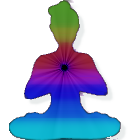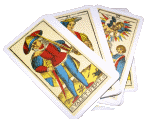
Haindl Tarot
TEN OF STONES - RICHNESS
NEW TITLE: "THE RICHNESS OF THE EARTH"
I CHING: 48, CHING, "THE WELL"
REVERSED I CHlNG: 47, K'UN, "OPPRESSION"
Once again the name change makes clear that the Haindl Tarot concerns itself with a richness beyond money. It also reminds us that we need to think of nature and the world around us as well as our own prosperity. The stones form the same pattern as the ten cups in the final Water card. This indicates to us that richness does not mean only material wealth (though it does not reject that either), but also happiness and a good life. In some decks this card mainly represents prosperity. Hermann Haindl has said that he wanted his version to go beyond the traditional meaning in order to show the richness of an abundant nature, a sense of both the world and the individual person, healthy and alive.
In the hexagram we find an image of the spiritual origins of wealth. The number is 48, which Wing calls "The Source." He describes it as the divine source of nourishment and meaning. Inexhaustible, it never changes, for it exists beyond the material forms it awakens. We can think of it, perhaps, as the light in the card of the Moon.
Wilhelm stresses the commonplace image that serves as the symbol, or inspiration, for this powerful understanding. He titles the hexagram "The Well," one of the two, along with "The Cauldron" (the hexagram on the Three of Wands), that show a man-made object. In ancient China, styles of architecture varied greatly from region to region and in different historical periods. However, the wells remained the same design, everywhere and up to the modern age. Therefore, the well signifies something that does not change, whatever the location or outer circumstances. This gives the idea of an eternal truth. But since a well gives water, the most basic necessity of life, it also signifies the fundamental energy of being.
The reversed hexagram is 47, "Oppression," the hexagram from the Five of Swords. We must not take the richness of the Earth for granted. We must be careful to nourish life rather than oppress nature.
The last of the Stones cards, the Ten of Stones, shows the culmination of the pattern we've seen develop through the suit and through the series of suits. Prudence and modesty have solidified the gains produced by good fortune, which in turn comes (as a response from life) after the person has acquired knowledge. And so we end with richness, where the stones in the Ten of Stones repeat the pattern of the Nine of Stones, except that the middle stone becomes doubled. This doubling indicates that the good fortune does not simply vanish, but establishes itself as a new basis for the person's life. And because the Stones cards are communal, these two stones go beyond the individual to society and nature.
The Ten of Stones can almost be said to culminate the entire Haindl Tarot as well. The Star and Aeon gave us images of the process of renewal. Here we look forward to the way the new world will be when the renewal has occurred. Knowledge and good fortune gain a wider meaning as well, because of this card. We can see them in the context of our planet's hope for "richness" or "health:"
The background for the Ten of Stones comes from the Oedipus painting we saw with the Five of Wands. That card indicated conflict, and people striving to escape history. It also showed a personal transformation. Here the transformation has been completed. In place of battle, we see new life. In a deep valley water rushes forth, white and foaming, like mountain snow melting in the spring. Above the cleft of rock we see a bright sky, brightest just above the middle stone, as if the sun is rising. The light appears vague, shining through a mist. We get a feeling that these remnants of clouds will soon vanish, because already the sun is shining on the waters.
DIVINATORY MEANINGS
In readings, we once again bring the card down to the individual level. It should be clear, however, that the cards do not lose their wider implications when we interpret them in a mundane way. Part of the purpose of readings is to show the ways our lives mirror the patterns of the greater world. The Ten of Stones refers to a good life, to health, and to a sense of solid reality. Like the Universe, it shows the materialization of the person's hopes and desires. The meanings of the card may depend on the question. If someone asks about money, then that is what the card will mean. But the other meanings will not vanish, even when we do not see them.
REVERSED
Reversed, the Ten of Stones can have two meanings. One is that a potential good development has not yet occurred. This does not mean failure, but rather delay, as if the snow has not melted or the sun has not risen above the rocks. Another meaning would indicate that the material wealth and security are there, but the person does not appreciate their value. Too much attention has been focused on outer concerns without that inner dimension, that awareness of the Source, which gives "Richness" its meaning.
HET OORDEEL
De Waterput.
Men kan wel de stad verleggen,
Maar de waterput niet.
Hij neemt niet af en neemt niet toe.
Zij komen en gaan en scheppen uit de waterput.
Als men het welwater bijna heeft bereikt,
Maar het touw net niet lang genoeg is,
Of als de kruik breekt, dan brengt dat ongeluk.
HET BEELD
Boven het hout is het water: het beeld van de Waterput.
Zo moedigt de edele het volk aan
En vermaant hij het, elkaar te helpen.










